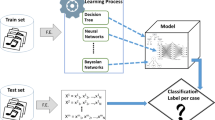Abstract
Music Information Retrieval (MIR) has been a popular area of research since its inception. Music can be divided into some conventional categories, called music genres, based on a certain set of features such as orchestral instruments, rhythm, and tempo. The MIR community has made tremendous efforts to solve the problem of music genre classification. In this work, we have analysed how the number of genres affects the accuracy of various machine learning models. This paper also presents a novel approach towards the challenge of identifying the genre of a given audio clip using an ensemble model with an accuracy of 90.3%.
Access this chapter
Tax calculation will be finalised at checkout
Purchases are for personal use only
Similar content being viewed by others
References
H. Raj, A. K. Dubey, V. Deep, Anuranjana, Music Genre Classification Using Machine Learning. Lecture Notes in Mechanical Engineering (2021), pp. 763–774. https://doi.org/10.1007/978-981-15-9956-9_74
Y. Zhung, J. Zhou, A study on content-based music classification, in Proceedings of the 7th International Symposium on Signal Processing and Its Applications. ISSPA 2003, vol. 2 (2003), pp. 113–116. https://doi.org/10.1109/ISSPA.2003.1224828
G. Tzanetakis, P. Cook, Musical genre classification of audio signals. IEEE Trans. Speech Audio Process. 10(5), 293–302 (2002). https://doi.org/10.1109/TSA.2002.800560
T.G. Dietterich, Ensemble methods in machine learning. Mult. Classif. Syst. 1857, 1–15 (2000). https://doi.org/10.1007/3-540-45014-9
D. Pye, Content-based methods for the management of digital music, in Proceedings of the International Conference on Acoustics, Speech, and Signal Processing (ICASSP), vol. 4 (2000), pp. 2437–2440. https://doi.org/10.1109/ICASSP.2000.859334
M.F. Mckinney, Features for Audio and Music Classification (2013)
S. Zhang, Music Genre Classification: Near-Realtime Versus Sequential Approach (2019)
C. Science, et al., Music genre classification using deep learning, in ICCMC (2022), pp. 974–978
J.K. Bhatia, R.D. Singh, S. Kumar, Music genre classification, in 2021 5th International Conference on Information Systems and Computer Networks (ISCON) (2021), pp. 1–5. https://doi.org/10.1109/ISCON52037.2021.9702303
A.B. Chan, A. Hon, W. Chun, T.L. Li, A.H. Chun, Automatic musical pattern feature extraction using convolutional neural network, in SmartPalette View Project FlexyFont View project Automatic Musical Pattern Feature Extraction Using Convolutional Neural Network, vol. I (2010), p. 2246, https://www.researchgate.net/publication/44260643
“librosa - librosa 0.9.2 documentation”, https://librosa.org/doc/latest/index.html. Accessed 16 August 2022
S. Sigurdsson, K.B. Petersen, T. Lehn-Schiøler, MEL frequency cepstral coefficients: an evaluation of robustness of MP3 encoded music, in ISMIR 2006–7th International Conference on Music Information Retrieval, vol. 5 (2006), pp. 286–289
M. Müller, S. Ewert, Chroma toolbox: Matlab implementations for extracting variants of chroma-based audio features, in 2011 Proceedings of the 12th International Society for Music Information Retrieval Conference (ISMIR) (2011), pp. 215–220
J. Shen, et al., Natural TTS synthesis by conditioning Wavenet on MEL spectrogram predictions, in Proceedings of the IEEE International Conference on Acoustics Speech Signal Processing (ICASSP), vol. 2018 (2018), pp. 4779–4783. https://doi.org/10.1109/ICASSP.2018.8461368
D.N. Jiang, L. Lu, H.J. Zhang, J.H. Tao, L.H. Cai, Music type classification by spectral contrast feature, in Proceedings of the 2002 IEEE International Conference on Multimedia and Expo (ICME), vol. 1 (2002), pp. 113–116. https://doi.org/10.1109/ICME.2002.1035731
D. Tymoczko, The generalized Tonnetz. J. Music Theory 56(1) (2012) https://doi.org/10.1215/00222909-1546958
Precision vs Recall | Precision and Recall Machine Learning, https://www.analyticsvidhya.com/blog/2020/09/precision-recall-machine-learning/. Accessed 16 August 2022
Author information
Authors and Affiliations
Corresponding author
Editor information
Editors and Affiliations
Rights and permissions
Copyright information
© 2023 The Author(s), under exclusive license to Springer Nature Singapore Pte Ltd.
About this paper
Cite this paper
Singhal, K., Chawla, S., Agarwal, A., Goyal, P., Agarwal, A., Rana, P.S. (2023). Ensemble Model for Music Genre Classification. In: Bhattacharya, A., Dutta, S., Dutta, P., Piuri, V. (eds) Innovations in Data Analytics. ICIDA 2022. Advances in Intelligent Systems and Computing, vol 1442. Springer, Singapore. https://doi.org/10.1007/978-981-99-0550-8_32
Download citation
DOI: https://doi.org/10.1007/978-981-99-0550-8_32
Published:
Publisher Name: Springer, Singapore
Print ISBN: 978-981-99-0549-2
Online ISBN: 978-981-99-0550-8
eBook Packages: Intelligent Technologies and RoboticsIntelligent Technologies and Robotics (R0)




